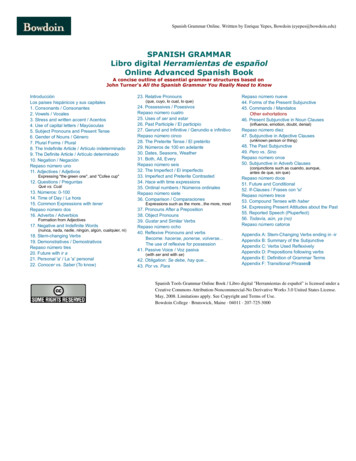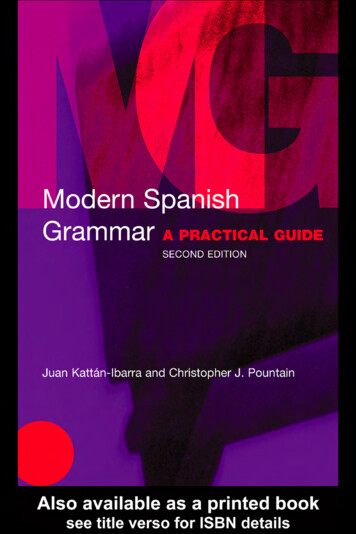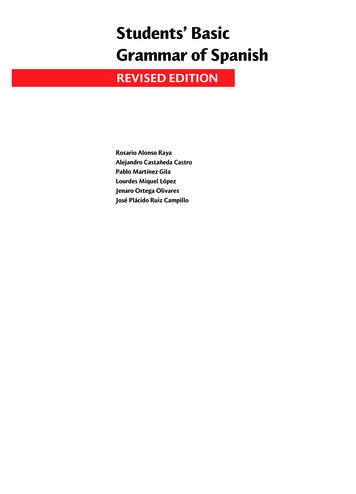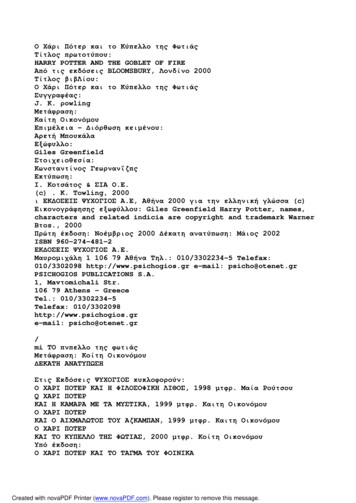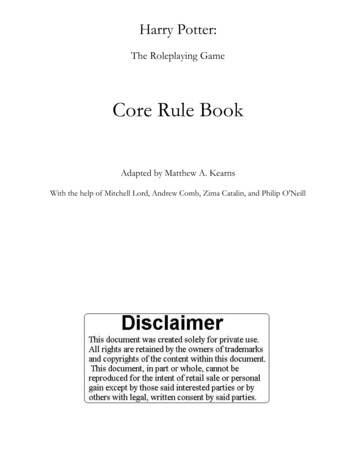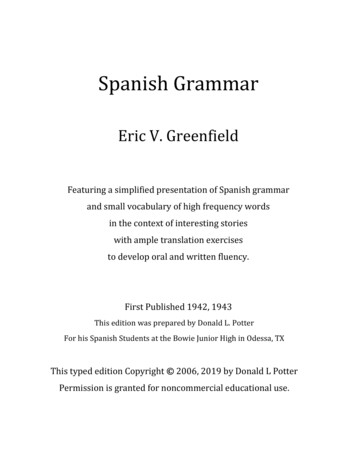
Transcription
Spanish GrammarEric V. GreenfieldFeaturing a simplified presentation of Spanish grammarand small vocabulary of high frequency wordsin the context of interesting storieswith ample translation exercisesto develop oral and written fluency.First Published 1942, 1943This edition was prepared by Donald L. PotterFor his Spanish Students at the Bowie Junior High in Odessa, TXThis typed edition Copyright 2006, 2019 by Donald L PotterPermission is granted for noncommercial educational use.
PrefaceAs its name implies, this book contains only the prime essentials of Spanish grammar; itsone and only purpose is to serve as a textbook for those beginning the study of Spanish. Itschief objectives are to identify, explain, and exemplify the high points of Spanish Grammar,and through persistent repetition in abundant reading and translation exercises, to implant abasic vocabulary of 620 words. The fundamental keynotes of this book are simplicity andrepetition.Mature, well-prepared students, reciting three times a week, can easily master the thirtysix lessons of this text in one semester; in my judgment, however, students will eventuallyloose nothing in time or accomplishment if they devote one and a half semesters, or even awhole year to the beginning grammar.This Spanish grammar is not the result of a capricious impulse to add one more book to analready overcrowded field, but is rather the outgrowth of several ideas that have insistentlyforced themselves upon me in my seventeen years of experience teaching beginning Spanishwith various excellent and mediocre textbooks. These ideas, which, I trust will conduce tosimplification and clarification in presenting Spanish grammar, and which I have tried toemphasize in this book, are:(a)(b)(c)(d)Topical or unitary lessonsVery small vocabulary (620 words)Simplified treatment of the verbComplete one-page conjugations of verbs.TOPICAL OR UNITARY LESSONS. All Spanish texts must contain the prime essentials ofSpanish grammar, whether they be distributed over sixty lessons or compressed into sixteen.The sixteen-lesson book must, obviously, crowd several grammatical themes into onechapter. As to grouping of units, it seems to me far more effective strategically andpedagogically to divide the grammar into its unitary difficulties and to attack these unitsindividually, rather than in combinations of four, three, or even two. Hence the thirty-sixlessons in this book, each devoted to one prime unit of Spanish grammar.620-WORD VOCABULARY. Individual views on the ability of students to acquirevocabulary in a foreign language vary mostly widely, probably because of confusion in theuse of the terms active vocabulary and passive vocabulary. It is axiomatic, however, thatwords are learned and retained largely in proportion to the number times they areencountered, whether audibly or visually, and especially in proportion to the number of timesthey are made use of in a conscious effort to express a complete thought or idea. Thevocabulary herein suggested consists of 620 (650, if numbers are included) different wordsselected on the basis of Buchanan’s Graded Spanish Word List (1927). Some 84% of thesewords are found in the basic first thousand of Buchanan’s Word List, and nearly 15% in thesecond thousand, a very few words have been introduced arbitrarily. These 620 words aremeant to be a working, active vocabulary. I believe that a student, who in one year acquiresand uses with facility both in composition and conversation the 620 words herein suggested,accomplishes all that we can reasonably expect and demand of him in the field of activevocabulary. This book, however, because of its small vocabulary, can be used effectively bythose desiring to complete the grammar in one semester.i
LOGICAL SEQUENCE OF PRESENTATION. Any sequence of grammar lessons that everhas been, or ever can be, devised, will be subject to harsh criticism, since practically everyunit of grammar has its proponents who demand for it a position at the first part of the book.The whole problem consists in putting main things first and in relegating things of lesserimportance to the latter part of the book, -- a problem that cannot be solved to the satisfactionof everyone. Lessons one and two, by common consent, seem to be the proper area forpresenting the present tense of estar and ser; and the very end of the grammar, by almostuniversal agreement seems to be the proper place for the passive voice. But who will decidewhere the present subjunctive should be introduced? In lesson five, as in one book, or inlesson twenty, as here? Shall the possessive adjectives be assigned to lesson twenty-seven, asin one book, or to lesson seven, as here? Shall the present, past, and future tenses be treatedin one lesson, as in one book, or individually, as here? Shall the perfect tenses be combinedin one lesson, as in some books, or treated individually as here? This problem is indeed sodifficult that probably no two teachers could come to total agreement as to what constitutesperfect sequential arrangement of the Spanish grammar. The writer of this book lays no claimto having formulated the one definitive grammatical sequence, but does insist that herecognized this problem and, at least, consciously endeavored to solve it from the points ofview of natural development, and of relative importance of individual units.SIMPLIFIED TREATMENT OF VERBS. The simplified treatment of verbs, as hereinsuggested, is, if not entirely an innovation, at least, novel. Instead of loading the studentdown with lessons of dry and confusing explanations on the various mutations of the radicalchanging verbs, it seemed to sufficient to give examples of these verbs. Moreover, only fifthtwo verbs that can be classified as irregular or radical-changing are used in the whole book;complete conjugations of twenty-eight of these verbs, and outlines of the other twenty-fourwill be found in a special section.COMPLETE ONE-PAGE CONJUGATIONS, in which the structural relationships and beautifulsymmetry of the various moods and tenses are shown, are, I believe, something entirely newin Spanish grammar. Many students have assured me that they never understood thestructure, or appreciated the symmetry, of the Spanish verb until they had carefully writtenout the complete conjugation of several verbs on the plan suggested. These twenty-eightcomplete one-page conjugations of various types of verbs are indeed one of the mainimpulses in the making of this bookIn conclusion, I wish to express my hearty gratitude and deep indebtedness to my dearfriend and colleague, Professor Edwin Brenes, who has so conscientiously read and correctedmy manuscript, and made many helpful suggestions.I am deeply grateful also to Dr. Roger R. Walterhouse and the Barnes & Noble staff fortheir kindly aid and constructive criticism.E. V. GreenfieldAbout the Author: Erick V. Greenfield received his A.B. degree from Colgate University and his A.M. degreefrom Harvard University, and then studied intensively abroad, in Spain, France, and Germany. After holdingvarious teaching posts, he joined the faculty of Purdue University where he taught for more than forty years,and holds the rank of Professor Emeritus of Modern Language. He is the author of numerous textbooks,including Technical and Scientific German; Industrial and Scientific French; and German Grammar (anothervolume in the College Outline series.). From the 1943 edition.ii
SPANISH GRAMMARTable of ns:1. First Conjugation Verbs (AR) (Present Tense)2. Estar (Present Tense)3. Second Conjugation Verbs ER (Present Tense)4. Ser (Present Tense)5. Subject Personal Pronouns.6. Third Conjugation Verbs (IR) (Present Tense)7. Possessive Adjectives8. Radical (Stem) Changing Verbs9. Personal Pronouns after Prepositions – Negation10. Present Tense of Some Irregular Verbs11. Personal Pronouns (Indirect and Direct Objects)12. Preterit Tense (Definite Past)13. Preterit Tense of Some Irregular Verbs14. Past Tense (Continuity, Description) – Imperfect Tense15. Tener and Its Idioms16. Relative Pronouns17. Present Subjunctive18. Some Irregular Present Subjunctives19. Commands20. Demonstrative Adjectives21. Future Tense – Present Conditional22. Reflexive Verbs23. Time of Day24. Present Perfect Tense – Participles25. Comparison of Adjectives and Adverbs26. Numerals27. Past Perfect Indicative28. Days – Months – Seasons29. Future Perfect Indicative – Perfect Conditional30. Survey of Moods and Tense31. Past Subjunctive32. Simple Conditions – Present Unreal Conditions33. Demonstrative Pronouns – Possessive Adjectives34. Past Perfect Subjunctive35. Past Contrary-to-Fact Conditions36. Passive VoiceVerbsVocabulary (Spanish – English)Vocabulary (English – 56972768084899498102106109114119122126129134138
Spanish GrammarA Skill Mastery Approach to Total Linguistic FunctionIn SpanishWritten by Erick V. Greenfield – 1942, 1943Edited and Reprinted by Donald L. Potter – 2005, 2019INTODUCTIONI. Pronunciation.Although Spanish grammars tell us that many letters are pronounced the same inSpanish as in English, no letter in the Spanish alphabet has exactly the samepronunciation as in English. Special attention must be given to the Spanish vowels,to make them clear, clean-cut, and without the glide that is so common in English.The pronunciation of any foreign language is acquired principally throughimitation and practice. Independent reading of rules on pronunciation, except byexperienced language students, is largely useless. Every rule here given should beread aloud in class and commented upon by the instructor. The lists of illustrativewords under each rule are made long intentionally, in order to provide ampleopportunity for individual students and groups of students to imitate the teacher’spronunciation.Remember the proper order for learning a language is: Listening – Speaking –Reading – Writing (self-expression). Listening is the foundation for everythingelse. Total Linguistic Function means competence in hearing, speaking, reading,and writing.Note Concerning the Alphabet: Prior to 2010, The Real Academia Española had included ch and llofficially recognized letters, having a distinct pronunciation, much like “ch” does in English. When thealphabet was updated, they were dropped from the alphabet. Now the English and Spanish alphabets are thesame except for the addition of the letter ñ after n. Here are the letters and ere (or erre)eseteuuveuve doble, dobleX: equisY: yeZ: zetav
1. Vowelsaa as in father.pan, clase, papel, hablar, casa, bajo, madree(1) a in take, at the end of a syllable (open syllable)mesa, clase, necesario, decir, leer, señor, eso(2) e in set, when a consonant ends the syllable (closed syllable)cerca, used, sentado, saber, verdadi (y) pronoun in machine.ir, decir, sufrir, principal, minuto, libre, leyo(1) o in open, at the end of a syllable (open syllable)hijo, caballo, otro, todo, ojo, eso, señora(2) like ou in bought, when a consonant ends the syllable (closed syllable).señor, contra, sombrero, dormir, caloruu in rule.mucho, nunca, pluma, una, buscar, estudiar2. Consonants.bcchdfghjnot as explosive as in English, the lips almost touch, but let the air passbetween them. When initial letter, or after m or n, pronounce like b in bone.beber, descubrir, trabajo, escribir, bastante, pueblo, también(1) c in come, before a, o, u, or a consonantcomer, café, cuarto, corto, poco, escuela, casa, clase(2) c before e or i is pronounced like s in thus, so.hacer, cinco, nación, decir, ciencia, preciso(In Spain c before e or i is pronounced like th in thin.)ch in much.mucho, ancho, muchacho, dicho, escucharEnglish d, between vowels and at the end of a word, like th in they.donde, sed, pared, todo, vender, vida, madre(In Latin American Spanish, final d is often dropped:Madrid, sed, verdad, ciudad, usted).English f.frío, falta, defender, francés, difícil.(1) g in give, before, a, o, u, or a consonant.pagar, gozar, algunos, gracia, gustar, agosto(2) before e and i, it has a throaty h sound.general, gente, ligero, sumergir, gitanoalways silenthacer, hoy, hay, ahora, hermanoh as in hawk.jardín, julio, ejercicio, lejos, ejemplo, Juanv
klllmnñpqurrrstvxyzEnglish k, occurs only in foreign words.kilogramo, kilómetroEnglish l.lejos, isla, general, libro, luz, salud, fácily as in yes.caballo, llegar, calle, valle, llamar, hallarEnglish m.tomar, mano, minuto, llamar, importarEnglish n.junio, mano, general, pan, negro, noche, juntony in canyon.señor, niño, pequeño, cañón, año, engañarEnglish p without aspiration – following puff of air.poner, princesa, rápido, posible, tiempo, guapok; occurs only with e and i.que, aquí, querer, quizás, aquelEnglish r but with tongue touching roof of mouth behind teeth;when initial, it is trilled.rojo, rey, rico, río, servir, secreto, trabajarsame as r, but with a decided trill. (Practice rapidly saying the English butter.)guerra, arroz, arriba, sierra, irregulars in some [In mismo (same), it is pronounced z.]siglo, rosa, princesa, siempre, lunes, asíEnglish t; tip tongue must touch upper teeth. No puff of air.tener, santo, sentado, vista, último, tinta, tierrav, but not explosive, as in English; like Spanish b; the lips almost touch, butlet the air pass between them.vivir, verde, verano, uva, joven, favor(1) between vowels, gs.examen, éxito, existir(2) before a consonant, s.exclamar, explicar, extremoas in consonant, y in yes.yo, ayer, ayudar, mayors in so, thus. [Castilian, th in thin.]cruz, taza, zapato, paz, pobreza, riquezavi
3. Diphthongsa, e, o, are strong vowels.i (y), u are weak vowelsTwo strong vowels cannot stand together in one syllable.de-se-o, de-se-ar, i-de-a, te-a-troA strong and a weak vowel, or two weak vowels together, form adiphthong and hold together in one syl
07.10.2019 · As its name implies, this book contains only the prime essentials of Spanish grammar; its one and only purpose is to serve as a textbook for those beginning the

